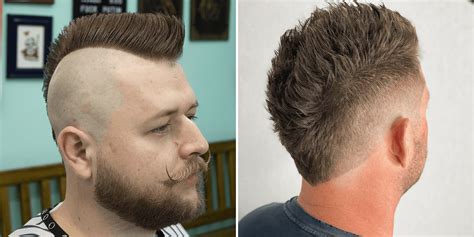Introduction

The faux hawk and mohawk are two iconic hairstyles that have gained immense popularity over the years. While they share some similarities, they also possess distinct features that cater to different tastes and preferences. This comprehensive analysis aims to explore the key differences between these two hairstyles, providing insights into their respective advantages, disadvantages, and cultural significance.
Definition and Characteristics
Faux Hawk
- Definition: A variation of the mohawk where the hair is shaved or trimmed on the sides, leaving a strip of longer hair running down the center of the head.
- Characteristics: The faux hawk typically has shorter sides (less than 2 inches) and a longer top section (up to 4 inches). The top hair can be styled upright or swept to one side, creating a voluminous or sleek look.
Mohawk
- Definition: A hairstyle characterized by a strip of long hair running down the center of the head, with the sides shaved or closely cropped.
- Characteristics: The mohawk typically has long hair on the top section (6 inches or more) and shaved sides (less than 1 inch). The long hair can be styled into various shapes, such as a spike, a crest, or a brush.
Advantages and Disadvantages
Faux Hawk
Advantages:
- Versatility: Can be styled in multiple ways, allowing for customization and adaptability to different occasions.
- Less maintenance: Requires less frequent trims and styling compared to the mohawk.
- Suitable for various face shapes: Flattering for most face shapes, adding height and creating an illusion of length.
Disadvantages:
- Can appear exaggerated: May not be suitable for conservative or professional settings.
- Potential for hair damage: Constant styling can weaken hair follicles and lead to breakage.
Mohawk
Advantages:
- Bold and distinctive: Makes a strong statement and exudes confidence.
- Expresses individuality: Allows for creative styling and customization, reflecting personal style and artistic expression.
- Cultural significance: Associated with various subcultures, including punk, rock, and heavy metal.
Disadvantages:
- High maintenance: Requires regular trims and styling to maintain its shape.
- May limit hairstyles: The long hair section restricts the range of hairstyles that can be achieved.
- Not suitable for all occasions: May be inappropriate for formal or work environments.
Cultural Significance
Both the faux hawk and mohawk have strong cultural associations. The faux hawk gained popularity in the 1980s and 1990s, influenced by the punk and new wave movements. It was commonly adopted by musicians, performers, and fashion icons.
The mohawk traces its origins back to the Native American tribes, particularly the Mohawk Nation. It symbolized strength, courage, and tribal identity. In contemporary society, the mohawk has become synonymous with rebellion, counterculture, and individuality.
Styling and Hair Care
Styling a faux hawk or mohawk requires specific techniques and products. For the faux hawk, start by applying a volumizing mousse or gel to the top section. Then, blow-dry the hair upwards, using a round brush to create volume. Finish by setting the hair with hairspray.
For the mohawk, the hair on the top section should be washed and conditioned regularly to maintain its health and vitality. Use hair products designed for hold and shine, such as gels or pomades. To style, apply the product to the damp hair and shape it into the desired form.
Target Audience and Market Size
The target audience for the faux hawk and mohawk encompasses individuals seeking unique and expressive hairstyles.
According to Statista, the global hair care market is projected to reach $233.7 billion in 2025. The segment of styling products, which includes gels and pomades used for these hairstyles, is expected to experience significant growth.
Strategies for Innovation
To innovate and differentiate in the faux hawk and mohawk market, manufacturers can explore the following strategies:
- Create hybrid hairstyles that combine elements of both the faux hawk and mohawk.
- Develop hair products specifically formulated for these hairstyles, offering enhanced hold, protection, and shine.
- Partner with influencers and celebrities to promote and showcase creative styling techniques.
- Explore sustainable hair care practices, using organic ingredients and reducing the environmental impact of products.
Conclusion
The faux hawk and mohawk are two versatile and expressive hairstyles that cater to a wide range of individuals. While they share some similarities, their distinct features, cultural associations, and styling requirements appeal to different tastes and preferences. Understanding the nuances of these hairstyles enables consumers to make informed choices that align with their personal style and lifestyle. As the hair care market continues to evolve, manufacturers can innovate and capitalize on the growing demand for unique and bold hairstyles, such as the faux hawk and mohawk.
